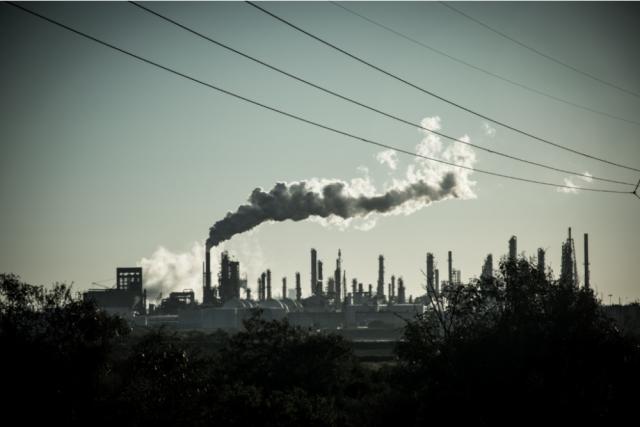
Oil refineries along the Gulf Coast are the source of emissions being targeted by developers of planned carbon capture and storage projects. (Source: Roschetzky Photography/Shutterstock.com)
Offshore E&P player Talos Energy Inc. has teamed up with U.K.-based Storegga Geotechnologies Ltd. in search of carbon capture and storage project (CCS) opportunities along the U.S. Gulf Coast and in the Gulf of Mexico.
Word of the joint venture (JV) was delivered June 8 by the Houston-based company amid a growing focus on emissions reductions for energy companies. The opportunity, which will target state and federal waters offshore Texas, Louisiana, Mississippi and Alabama, allows Talos to expand its offshore exploration and development knowledge into technologies energy experts say is crucial to meeting net-zero emissions ambitions.
“Engaging in CCS projects along the Gulf Coast and shallow-water Gulf of Mexico compliments our operating skill set and diversifies the company to seize this significant market opportunity,” Talos President and CEO Tim Duncan said in a statement. “We have a responsibility to deliver affordable, reliable energy with the lowest carbon footprint possible, and this joint venture allows us to expand our impact beyond our own assets to provide solutions for removing emissions from critical industrial sectors in our backyard.”
CCS is the process of capturing CO2 emissions, using a group of technologies, from various emission sources such as power plants, industrial complexes and petrochemical facilities—which surpass 100 along the coast. The CO2 is stored in geologic formations to prevent emissions from entering the atmosphere. Given the Gulf Coast area facilities emit more than 1 million tons of CO2 annually, the companies said it is a prime location for an offshore carbon capture project. Plus, the GoM is believed to hold more than 30 gigatons of available storage with rock properties and fluid type needed to effectively store CO2.
Talos’ Storegga partnership announcement comes more than a month after Exxon Mobil Corp. proposed a $100 billion carbon storage project for the Houston Ship Channel. The public-private project aims to store 50 million metric tons of CO2 by 2030.
Citing the U.S. Department of Energy, Exxon said the U.S. Gulf Coast has enough storage capacity to hold 500 billion metric tons of CO2. That, the company said, is equivalent to more than 130 years of total 2018 U.S. industrial and power generation emissions.
U.S. government officials along with others in different parts of the world have voiced support for such projects, saying it is critical to meeting climate targets. Companies pushing forward CCS projects have gained momentum recently. As of September, more than 30 commercial carbon capture, utilization and storage projects had been announced within the last three years, according to the International Energy Agency. Projects nearing a final investment decision together represent about $27 billion in potential investment.
Storegga, through its subsidiary Pale Blue Dot Energy, is behind the Acorn CCS and the Acorn Hydrogen projects in Scotland. Its partners are Royal Dutch Shell Plc and Harbour Energy Plc.
“The rapid deployment of CCS and carbon management value chains requires appropriate geological storage for carbon sequestration, access to emitters and existing infrastructure, and partnerships with experienced, like-minded organizations that share the desire to make this happen,” said Storegga CEO Nick Cooper. “The U.S. Gulf Coast offers significant potential for CCS and we are delighted to be partnering with Talos, a leading offshore operator.”
As explained in a news release, the Talos-Storegga JV will pursue CCS ventures with emitters, infrastructure providers, service companies, financing partners and others. The two said they are already actively seeking opportunities. As each CCS project progresses, each will be ring-fenced with separate operating agreements, financing structures and the possibility of additional working interest partners. Talos will serve as the JV’s operating partner.
There will be no upfront capital commitments, but partners will share costs 50:50 in the initial phases.
Recommended Reading
Helix Secures Multi-year GoM Contract with Shell Offshore
2024-09-04 - Under the contract, to begin in 2025, Helix Energy Solutions will provide well intervention services for Shell Offshore in the U.S. Gulf of Mexico.
BP Awards Subsea Alliance Contract for UK North Sea Development
2024-07-31 - SLB, OneSubsea, Subsea 7 and the Subsea Integration Alliance will increase speed of tool delivery, optimize installation and reduce rig days at BP’s Murlach development in the North Sea.
Offshore Guyana: ‘The Place to Spend Money’
2024-07-09 - Exxon Mobil, Hess and CNOOC are prepared to pump as much as $105 billion into the vast potential of the Stabroek Block.
Solaris Stock Jumps 40% On $200MM Acquisition of Distributed Power Provider
2024-07-11 - With the acquisition of distributed power provider Mobile Energy Rentals, oilfield services player Solaris sees opportunity to grow in industries outside of the oil patch—data centers, in particular.
Liberty Energy Warns of ‘Softer’ E&P Activity to Finish 2024
2024-07-18 - Service company Liberty Energy Inc. upped its EBITDA 12% quarter over quarter but sees signs of slowing drilling activity and completions in the second half of the year.
Comments
Add new comment
This conversation is moderated according to Hart Energy community rules. Please read the rules before joining the discussion. If you’re experiencing any technical problems, please contact our customer care team.






